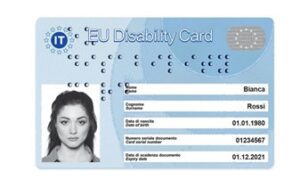
A few weeks ago, the EU Parliament adopted the proposal to establish a European Disability Card and a European Parking Card. Since this spring, people with disabilities can travel more easily through Europe.
The new document allows its holder to access special conditions or preferential treatments in many member states. Although some steps remain before the Directive enters into force, trials* showed good results and offered some indications for better development.
What may seem like a small innovation – in the end, the card extends rights that are already recognized -, it potentially impacts more than 100 million people who live in the EU with a disability. When it enters into force, it will grant them the same access to services, entertainment and public transport as the residents of the country they visit or travel to. Indeed, the introduction of this ID has been praised by the European Disability Forum, which described this policy as a “momentous victory,” besides its limitation – it is only meant for short stays (up to three months) and does not include people who temporarily move to another country, for example, within an Erasmus+ program.
The struggles
 But travelling is more than just having access granted to services, discounted fares, or parking spaces. The struggles to even access public transportation, museums, or entertainment venues are very real—and not only when visiting remote locations or ancient palaces. Thanks to a rise in awareness, which has also been pushed by growing concerns about the continent’s readiness to answer the needs of an ageing population, some cities are taking notes and moving accordingly.
But travelling is more than just having access granted to services, discounted fares, or parking spaces. The struggles to even access public transportation, museums, or entertainment venues are very real—and not only when visiting remote locations or ancient palaces. Thanks to a rise in awareness, which has also been pushed by growing concerns about the continent’s readiness to answer the needs of an ageing population, some cities are taking notes and moving accordingly.
In truth, accessible tourism has become a topic of discussion among travel bloggers for some time now. It is a social media buzzword, and with the holiday season, it is a trending topic on Google. CondéNast Traveller also compiles a list of the “most accessible cities” of the year, using data from TripAdvisor and Yelp. In 2024, London takes the lead in Europe. The British capital is followed by Paris, Amsterdam, Oslo, Dublin, Wien, Reykjavik and Madrid. And, entering this list, Rome closes the top ten.
Not only for tourists
Lists aside, to answer the clear demand for better planning, in recent years, many local administrations have been working to accommodate (at least some) disabilities with bigger plans that, in the end, benefit the needs of most residents. Yet, sure enough, we are still far from seeing all obstacles flattened. According to the UK Department of Transport study “Disabled People’s Travel Behaviour and Attitudes to Travel” conducted some time ago, «25% of people with disabilities report difficulties with any type of trip, compared with 10% of people without disabilities.»
 Yet, after years of attention to accessibility themes, some structures and services should now be given (almost) for granted, especially if we are talking about places which economies thrive with tourism. At the end of the day, accessible cities are not only those that offer better and more widespread services for those (residents or tourists alike) with a physical or mental impairment but also those that apply a holistic approach. Lifts, parking spaces, and ramps to access buildings should (and in many instances are) now a given.
Yet, after years of attention to accessibility themes, some structures and services should now be given (almost) for granted, especially if we are talking about places which economies thrive with tourism. At the end of the day, accessible cities are not only those that offer better and more widespread services for those (residents or tourists alike) with a physical or mental impairment but also those that apply a holistic approach. Lifts, parking spaces, and ramps to access buildings should (and in many instances are) now a given.
With the rise of interest, some cities are setting the bar higher and taking steps ahead in planning also more accessible cultural events. Among other initiatives, for example, some museums already provide “quiet” hours to allow people who are sensible to lights or loud sounds to enjoy their show. Other organizations are exploiting new technologies to provide better services for all. It happened recently at the Rijksmuseum in Amsterdam: thanks to an ambitious use of AI, the Dutch museum offers detailed descriptions of its collection for visitors who cannot see.
Europe’s most accessible city
Besides single attractions or venues, cities can even be recognized on a continental stage thanks to their efforts to become more attractive, sustainable, and accessible. The EU, for example, grants the “Access City Award”, this year given to San Cristóbal de La Laguna (Spain), with Łódź (Poland) and Saint-Quentin following just behind.
 The Spanish city was awarded in 2024 for “its comprehensive approach to accessibility and its dedication to improving the quality of life of persons with disabilities.” What stands out in its commitment are the interventions that interest urban spaces, social activities, and transportation. Today, for example, in San Cristóbal, vehicles and stations are fully accessible, and traffic lights have been implemented with acoustic signals. A special recognition was given to the work of the city’s Disability Council, which involves the direct beneficiaries of the planned improvements.
The Spanish city was awarded in 2024 for “its comprehensive approach to accessibility and its dedication to improving the quality of life of persons with disabilities.” What stands out in its commitment are the interventions that interest urban spaces, social activities, and transportation. Today, for example, in San Cristóbal, vehicles and stations are fully accessible, and traffic lights have been implemented with acoustic signals. A special recognition was given to the work of the city’s Disability Council, which involves the direct beneficiaries of the planned improvements.
* Belgium, Italy, Finland, Malta, Cyprus, Estonia, Slovenia, and Romania have been piloting the EU Disability Card since 2016. The success of these trials pushed Brussels to expand the initiative across the continent.
***
Alley Oop’s newsletter
Alley Oop arrives in your inbox every Friday morning with news and stories. To sign up, click here.
If you want to write to or contact Alley Oop’s editorial team, email us at alleyoop@ilsole24ore.com.